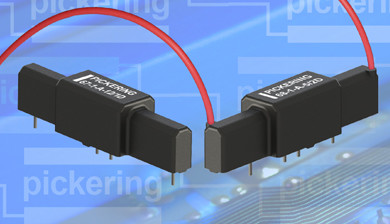So that’s what a 10 kV reed relay looks like
September 07, 2015
on
on

When I read this one I was curious, I’ve used reed relays before and as far as electrical devices go they don’t get much simpler, in fact you can actually see how it all works, there’s no mystery. Wave a magnet around and you can hear and see the contacts opening and closing.
They can be a good solution for a switching application, providing galvanically isolated enclosed contacts for use in volatile atmospheres. The only problem I've experienced is the occasional fused contact if too much current is allowed to flow, especially when the load is reactive. I had never really considered them suitable for high voltage applications.
These new reed relays from Pickering have a 10 kV stand-off rating and can switch an impressive 7.5 kV at 50 W with a switching speed of around 3 ms. The standard range of actuating coils are rated 5, 12 or 24 volt but other custom coil ratings are available to order. The series 68 reed relay has encapsulated flying leads so that the high voltage need not go anywhere near the PCB. Typical applications for these relays would be high voltage medical use such as defibrillators and also for break-down insulation testing equipment and ATE.
They can be a good solution for a switching application, providing galvanically isolated enclosed contacts for use in volatile atmospheres. The only problem I've experienced is the occasional fused contact if too much current is allowed to flow, especially when the load is reactive. I had never really considered them suitable for high voltage applications.
These new reed relays from Pickering have a 10 kV stand-off rating and can switch an impressive 7.5 kV at 50 W with a switching speed of around 3 ms. The standard range of actuating coils are rated 5, 12 or 24 volt but other custom coil ratings are available to order. The series 68 reed relay has encapsulated flying leads so that the high voltage need not go anywhere near the PCB. Typical applications for these relays would be high voltage medical use such as defibrillators and also for break-down insulation testing equipment and ATE.
Read full article
Hide full article


Discussion (1 comment)